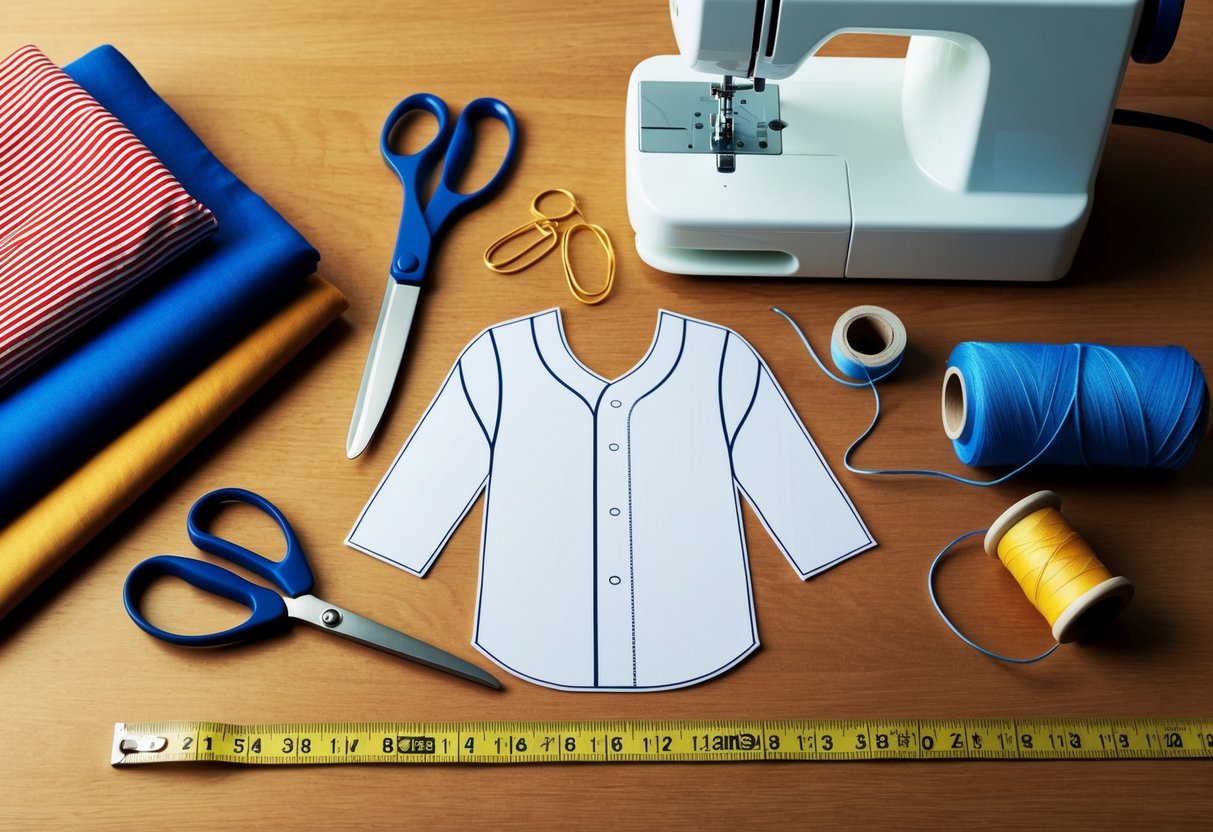Creating your own jersey offers a unique way to express your personal style or showcase your team’s identity. You can easily design a custom jersey by using online tools that let you choose colors, add logos, and personalize inscriptions.
With 3D design tools, the process is streamlined, allowing you to visualize your creation before ordering.
Table of contents
There are versatile options available for every sport, whether it’s basketball, soccer, or another team activity. Many platforms also provide templates and easy-to-use design labs that make crafting your perfect jersey simple and fun.
This approach ensures your jersey stands out, reflecting your unique vision or team’s spirit.
Customization doesn’t stop at appearance; you can select various materials to match your comfort and performance needs.
Some services offer quick delivery, so you won’t have to wait long to wear your creation. This modern approach makes it accessible for anyone to design a jersey that feels and looks just right.
Designing Your Jersey

Creating your own custom jersey can be an exciting and personal way to represent your team or business. This section guides you through the important steps in designing your jersey, from material choice to using advanced design tools.
Choosing the Right Material
Selecting the right fabric for your jersey is essential. Look for materials that are lightweight and breathable, such as polyester or a poly-blend. This helps keep you cool and comfortable during activities.
Some jerseys may use moisture-wicking materials to pull sweat away from your body. This feature is valuable if you’ll be active or outdoors.
Additionally, think about the jersey’s durability. High-quality fabrics ensure your custom team jerseys last through many washes and wears.
Understanding Jersey Sizes
When making custom jerseys, getting the right size is key for comfort and appearance. Jerseys might fit differently based on the manufacturer.
Checking a sizing chart can help you make an informed choice.
Take measurements of your chest, waist, and hips to find the best fit. Remember to consider how you like your jerseys to fit, whether snug or slightly loose.
If you’re designing for a team, gather size details from everyone to ensure proper ordering.
Selecting Your Design Aesthetics
Choosing the look of your jersey is a chance to express your team’s personality. Start with your team’s colors and logo. Decide if you want a simple, classic look or something bold and modern.
Think about utilizing gradients, patterns, or stripes to add unique flair. Including players’ names or numbers can also add a personal touch.
Consider how these elements will appear from a distance, especially in team sports where visibility matters.
Using a 3D Designer Tool
A 3D designer tool can revolutionize the way you create your jersey. With these tools, you can effortlessly visualize and customize your design before finalizing.
They allow you to adjust colors, patterns, and logos with precision.
These tools often come with templates and options like different neck styles or sleeve lengths.
They’re excellent for viewing the jersey from multiple angles, ensuring that you are satisfied with the entire concept.
Experiment with different features and ideas to see what works best for you.
Creating Your Artwork

Creating artwork for your jersey involves incorporating unique designs and personal touches. This part covers the use of clipart and graphic elements, as well as logos and emblems, to make your jersey truly stand out.
Incorporating Clipart and Graphic Elements
Adding clipart and graphic elements can enhance the look of your jersey. Use online design services where you can choose from a variety of pre-made images and shapes. These often include sports motifs, symbols, or abstract patterns.
When integrating clipart into your design, keep balance in mind. Too many elements can clutter the jersey, so focus on a few key graphics that align with your theme.
Consider using bold colors to make graphics pop, or opt for a subtle palette for a more understated look. The placement of these elements is important and can change the jersey’s appeal.
Experiment with different positions on the jersey to find one that works best for you.
Designing Logos and Emblems
Logos and emblems provide identity to your jersey. Start by sketching ideas on paper or using digital tools like Photoshop. Choose symbols that best represent your team or personal brand.
Simplicity is key in logo design. A good logo should be easily recognizable and scalable. Including text in your emblem can add more meaning, just ensure it remains readable.
Experiment with different fonts and text styles to see what fits well with your chosen symbol.
After you’ve settled on a design, use a digital design service to finalize and test how it looks on a jersey template.
Printing Techniques

Creating a custom jersey involves choosing the right printing method. Each technique offers unique benefits, whether it’s the vibrant colors of screen printing or the detailed designs of heat transfer and embroidery.
Screen Printing Essentials
Screen printing is a popular choice for vibrant and durable jersey designs. It involves creating a stencil (or “screen”) and applying ink onto the fabric through it.
This method allows for bold colors and is cost-effective for large runs, as multiple jerseys can be printed at once using the same screen.
The process requires several steps—preparing the screen, mixing ink, and drying the final print. Each color in the design demands a separate screen, which can add to the setup time.
It’s ideal for simple, bold designs with a limited color palette.
Heat Transfer vs. Embroidery
Heat transfer and embroidery are great for adding logos and small details.
Heat transfer uses special paper to apply ink to the jersey using heat. This method works well for detailed images and is suited for small batches, allowing flexibility in customization.
Embroidery, on the other hand, applies thread directly onto the fabric. It gives a textured, professional look and is highly durable, suitable for logos and text.
While embroidery adds elegance, it’s often more costly than heat transfer and may be less comfortable for active wear due to the raised texture.
Customization for Teams

Creating custom team jerseys involves designing for team identity and coordinating jerseys for various sports. Each aspect ensures that your team stands out with unique designs and effectively represents your group’s spirit and style.
Designing for Team Identity
When designing jerseys for your team, identity is key. Think about your team’s logo, colors, and values. Each jersey should reflect what your team stands for.
You might use bold colors and distinct patterns to make a statement.
Add elements such as your team name, player names, and numbers. This personal touch not only boosts team spirit but also makes each member feel special.
Use a design tool, like a 3D configurator, to see how your ideas come together before finalizing.
Coordinating Jerseys for Various Sports
Different sports have different jersey needs. Soccer jerseys, for example, need to be breathable and allow free movement, while baseball jerseys may need special features for durability.
Consider the specific requirements of each sport when customizing jerseys. Ensure that materials, cuts, and prints are suitable for the game’s demands.
Keep track of uniform rules for your sport, as competitions often have specific guidelines on what is allowed.
Using a mix of function and style in your custom jerseys ensures your team looks unified and professional across different sports.
Ordering Process

Creating a custom jersey involves choosing a reliable vendor and knowing the production and delivery timelines. These steps help ensure you get high-quality jerseys delivered when you need them.
Selecting a Reliable Vendor
Choose a vendor with a strong reputation in sportswear. Look for reviews and customer feedback online.
Check if they offer a 3D designer tool for creating personalized jerseys with your team’s logos and colors.
Make sure the vendor provides clear communication, like through email, for any inquiries or adjustments.
It’s essential to ensure they have on-staff artists to assist you with the design process, if needed.
Customer support plays a crucial role in a smooth ordering experience, so evaluate this aspect carefully.
Understanding Production and Delivery Timelines
Be clear about the production timeline. Vendors often have different processing times depending on the complexity of your design and order size.
Delivery timelines can vary, so ask the vendor about shipping options and their turnaround time. Sometimes, vendors may offer expedited shipping for an additional fee.
Understanding these timelines helps you plan your order so your jerseys arrive before key events or sports seasons. Always confirm all dates with the vendor to avoid surprises.
Aftercare and Maintenance

Proper care keeps your custom jersey looking its best and extends its lifespan. Learn how to wash, store, and handle your jerseys, especially if you have variations like different sizes.
Washing and Care Instructions
Wash your custom jersey inside out to protect any designs or logos. Always check the care label for specific instructions.
Use cold water and a gentle cycle machine to prevent fading or shrinking.
Avoid using bleach, as it can damage colors and graphics. Use a mild detergent instead.
Hand washing is effective for jerseys with intricate designs or delicate fabrics.
Air drying is essential. Hanging your jersey or laying it flat helps maintain its shape and size. Avoid direct sunlight, which can cause fading.
Iron only on a low setting, if needed, and never directly on designs.
Storing Your Custom Jerseys
For storage, hang your jersey using a padded hanger to maintain its form and size. If hanging is not an option, fold it carefully to prevent wrinkles and creases.
Keep it in a cool, dry place, away from direct sunlight to preserve colors.
Consider using garment bags to keep dust and moisture away.
Ensure you do not stack heavy objects on your jersey to avoid deforming prints or delicate materials. This care will help your jerseys remain as vibrant as the day you got them.
Frequently Asked Questions

Creating your own jersey involves picking the right design tools and understanding costs. The steps may vary depending on the sport, such as football or basketball.
What are the necessary steps to create a custom football jersey?
Start by selecting a color palette that represents your team. Use a design software or online tool to draft your ideas.
Incorporate your team’s logo and choose fonts for any text. Decide on the placement of numbers and names before finalizing your design.
Can you provide a guide to designing and making a basketball jersey from scratch?
First, research various styles and color schemes. Sketch your initial design or use a digital template.
Add the team name, player numbers, and any logos. Check that all graphics are properly aligned.
Once the design is complete, select a manufacturer or online printing service.
What are the best free online tools for designing a custom jersey?
Several platforms offer free tools, such as Canva, DesignEvo, and Smart Shirt Designer.
These allow you to craft simple jersey layouts by using templates and adding your custom artwork, logos, and text. They are beginner-friendly and suitable for basic designs.
How can I use an app to design a unique jersey for my team?
Apps like T-Shirt Design Studio and Snaptees can help with jersey design.
Start by choosing a template. Then, customize it with colors and graphics.
Upload your team’s logo and use the drag-and-drop feature to place it.
Adjust fonts and sizes as needed.
What is the cost range for producing a personalized sports jersey?
The cost of a custom jersey can vary widely.
Simple designs can start around $20. Meanwhile, more intricate patterns or higher-quality fabrics might reach upwards of $100.
Factors affecting cost include materials, printing methods, and quantity ordered.
How do I professionally incorporate a logo into my jersey design?
First, ensure your logo is high-resolution. Place it where it won’t interfere with other crucial elements like numbers and names.
Balance the logo size with other design components. Consider feedback from teammates or a design professional to ensure it looks cohesive.



